The National Museum of China (中国国家博物馆) is located in Beijing and is one of the largest and most comprehensive museums in the world. It was established in 2003 after the merger of the National Museum of Chinese History and the National Museum of Chinese Revolution, both of which were founded in the early 20th century.
The museum’s collection includes over 1.4 million artifacts, spanning China’s history from prehistoric times to the present day. The exhibitions cover a wide range of topics, including ancient Chinese art and culture, modern Chinese history, and the country’s natural resources and ecology.
The museum’s architecture is also a highlight, with a modern design that incorporates traditional Chinese elements. The building covers an area of 200,000 square meters, making it one of the largest museums in the world.
In addition to its extensive collection and impressive architecture, the National Museum of China also plays an important role in promoting cultural exchange and understanding both within China and with other countries. It regularly hosts international exhibitions and collaborates with museums and cultural institutions around the world to promote cross-cultural dialogues.
Table of Contents
- Location and Transportation
- Highlights of National Museum of China
- Map, Recommended Routes, and Must-See Treasures
- Vlog about National Museum of China
- A Brief History of the National Museum of China
- Useful Tips Summarized from Reviews
- Attractions near National Museum of China
- Explore Beijing Like A Local
Basic Information
| Website | http://www.chnmuseum.cn/ |
| Estimated Length of Tour | About 3 hours |
| Ticket Price | Free, but you must book online in advance |
| Opening Hours | 9.00 – 17.00; Last admission: 16.00 (1st January – 29th September) 9.00 – 16.30; Last admission: 15.30 (1st October – 31st December) Closed on Mondays |
| Telephone Number | 0086-010-65116400 |
Location and Transportation
The National Museum of China is located at 16 East Chang’an Avenue in the Dongcheng District of Beijing, China. The surrounding area is rich in history and culture, with many other major attractions within walking distance. To the west of the museum is Tiananmen Square, and to the east of the museum is the Forbidden City. You can get there easily by public transport.
Bus: Take bus 1, 2, 52, 82, 120, Tourist Line 1 or 2, get off at Tiananmen East, and you will be standing at the entrance of the National Museum of China.
Subway: Take subway line 1, get off at Tiananmen East Station, exit from Exit C or D, and you will see the entrance right in front of you.
Highlights of National Museum of China
Ancient Chinese Artifacts

The ancient Chinese artifacts in the National Museum of China are among the most impressive collections in the world. The museum houses over 200,000 pieces of Chinese art and artifacts from prehistoric times to the Ming and Qing dynasties. The collection includes bronze vessels, pottery, jade, porcelain, and other treasures that reflect the rich history and culture of China. Visitors can see rare and exquisite objects such as oracle bones used for divination, intricately designed bronze vessels used in rituals, and finely crafted jade objects. The collection provides insight into the development of Chinese art and culture over thousands of years and offers a glimpse into the daily lives of ancient Chinese people.
Calligraphy and Painting

The National Museum of China is home to an impressive collection of calligraphy and painting, showcasing China’s rich artistic traditions. The museum’s collection includes a diverse range of works, from ancient oracle bone inscriptions to contemporary paintings. Visitors can admire the exquisite brushwork and intricate details in pieces such as the Tang Dynasty masterpiece “Night Revels of Han Xizai” and the Qing Dynasty court painting “Ten Views of Lingbi Rock.” The calligraphy collection features works by renowned masters such as Wang Xizhi and Yan Zhenqing, with their elegant script capturing the beauty and fluidity of the Chinese language.
Revolutionary History
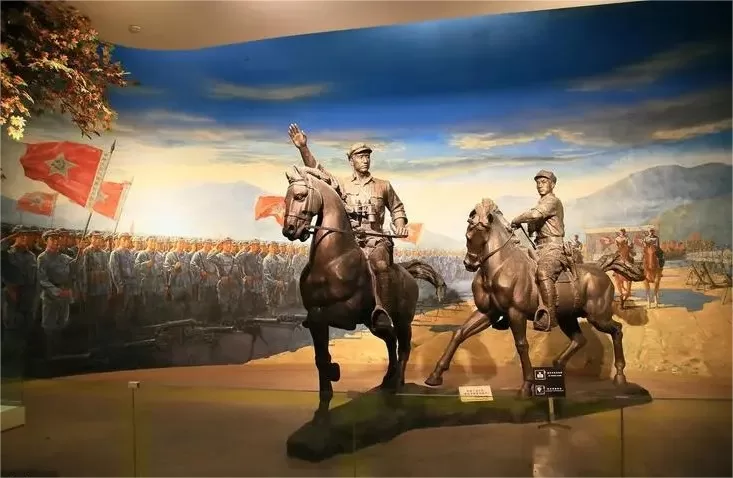
The Revolutionary History Display in the National Museum of China is a comprehensive exhibition that chronicles the history of China’s revolution from the late 19th century to the present day. The display features over 1,000 exhibits, including photographs, documents, and artifacts, that document the key events and figures of China’s revolutionary past. Visitors can explore the birth of the Communist Party of China, the struggle against foreign imperialism, the founding of the People’s Republic of China, and the country’s ongoing socialist development. Notable exhibits include the Red Army’s Long March map, Mao Zedong’s writing desk, and the bullet-riddled car in which Premier Zhou Enlai traveled during the Korean War.
Cultural Diversity
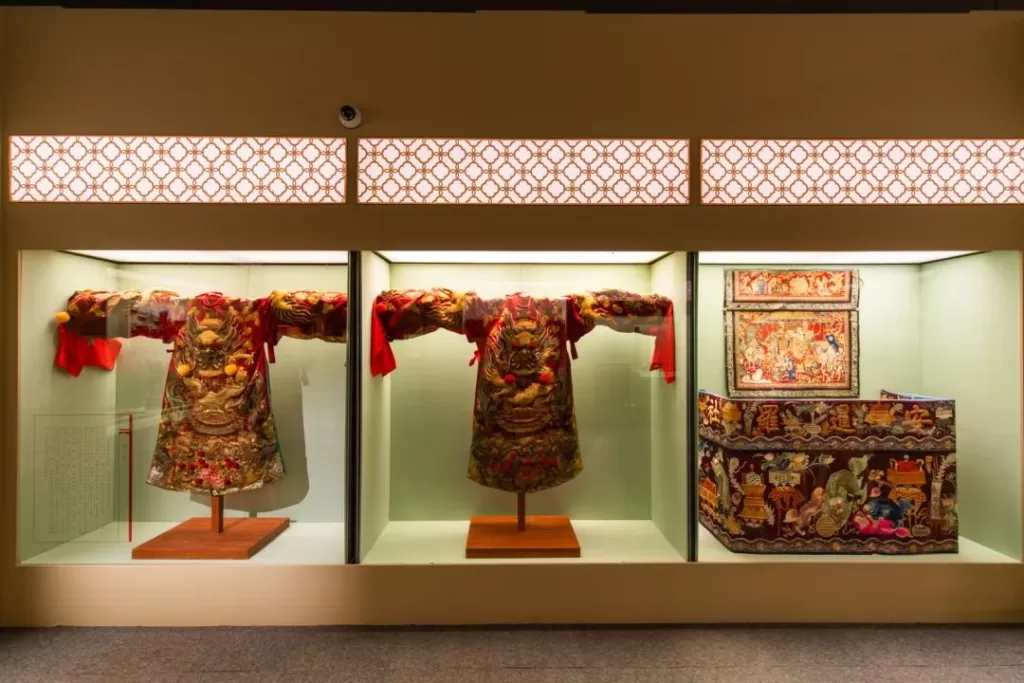
The National Museum of China celebrates the rich cultural diversity of China through its extensive collection of artifacts and exhibits. The museum showcases the art, customs, and traditions of China’s 56 ethnic groups, from the Han majority to smaller communities such as the Tibetans and the Uyghurs. Visitors can explore a variety of exhibits highlighting the unique cultural expressions of each group, including their traditional clothing, music, and cuisine. Notable exhibits include the colorful costumes of the Miao and Dong ethnic groups, the intricate embroidery of the Zhuang people, and the distinctive calligraphy of the Mongolian language.
Architecture
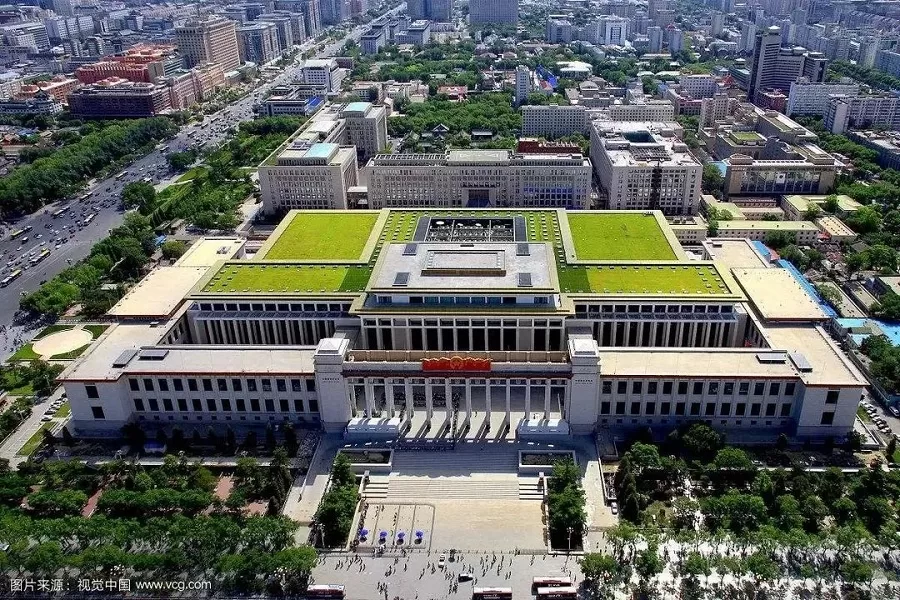
The National Museum of China is an impressive architectural masterpiece that seamlessly blends traditional Chinese design with modern features. The museum building covers an area of 192,000 square meters and boasts a unique shape reminiscent of a giant bronze tripod. The structure is made up of two main wings, with the northern section representing Chinese culture and the southern section representing Chinese history. The façade is decorated with traditional Chinese motifs, including cloud patterns and dragon scales, while the interior features modern galleries and exhibition spaces. The building’s design is also energy-efficient, utilizing natural light and ventilation to reduce its carbon footprint.
Map, Recommended Routes, and Must-See Treasures
Map of China National Museum
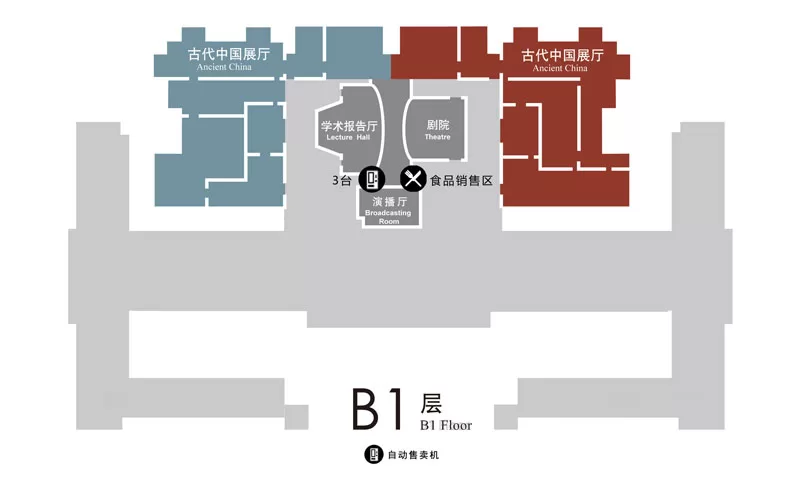
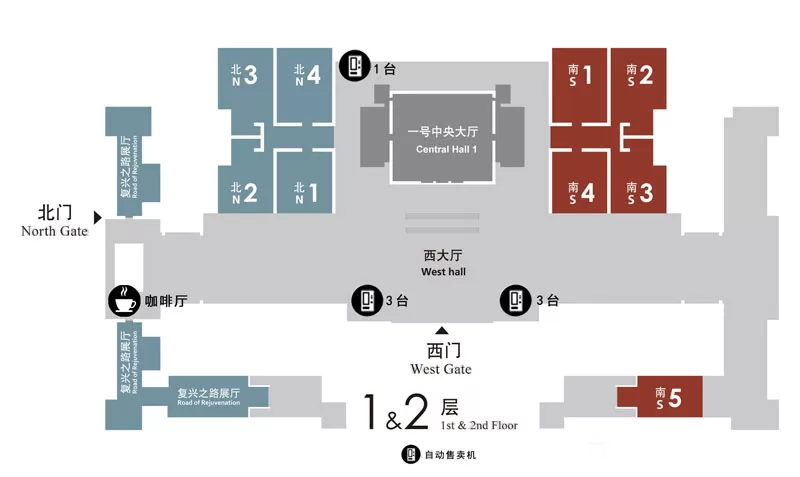
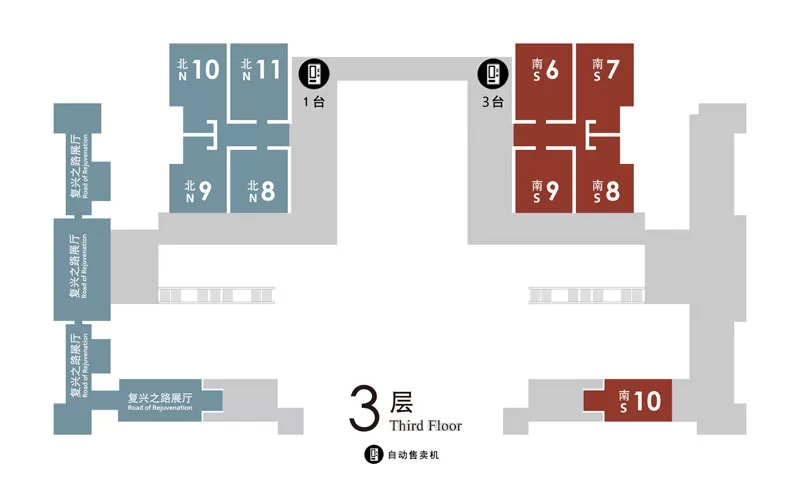
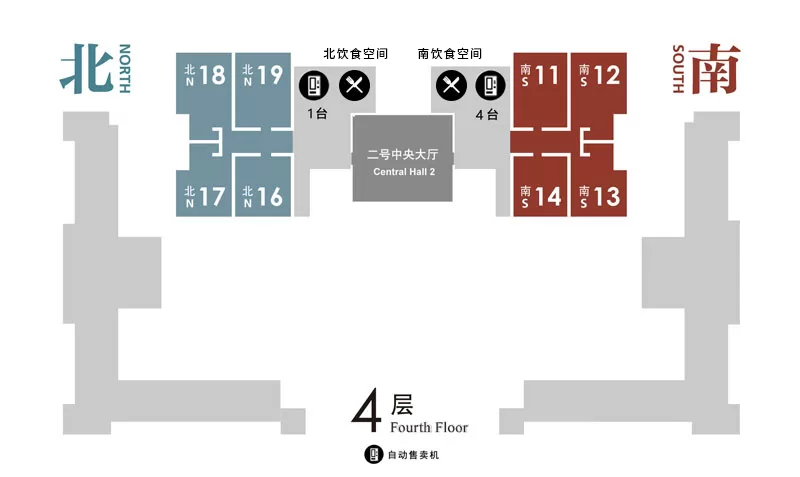
Recommended Routes
Start your visit in the basement level, where the Ancient China Basic Exhibition is located. This exhibition is organized chronologically and divided into eight halls, each dedicated to a specific dynasty and featuring artifacts that tell the story of each period.
After exploring the B1 floor, proceed to the second floor to view the exquisite Dehua white porcelain, the significant Road to Rejuvenation exhibit, and the special Lunar New Year exhibition.
Continue to the fourth floor to explore the rich collections of ancient coins, intricate bronze mirrors, stunning jade pieces, traditional costumes, and a wide array of porcelain artifacts.
Finish your tour on the third floor with the Ancient Dietary Exhibition, which showcases the culinary history and practices of ancient China.
Must-See Treasures
| Period | Artifact | Description | Location |
|---|---|---|---|
| Early Periods | Eagle-shaped Pottery Ding (鹰形陶鼎) | A pottery vessel from the Yangshao culture | B1, Ancient China |
| Painted Pottery Basin with Human Face and Fish Design (人面鱼纹彩陶盆) | A basin featuring human and fish designs from Yangshao culture | B1, Ancient China | |
| Painted Pottery Jar with Stork, Fish, and Stone Axe (鹳鱼石斧图彩陶缸) | A jar with detailed stork, fish, and stone axe motifs (currently on rest) | B1, Ancient China | |
| Jade Dragon (玉龙) | A jade artifact from Hongshan culture (moved to 2nd floor) | 2nd Floor | |
| Xia, Shang, and Western Zhou | Houmuwu Ding (后母戊鼎) | The largest ancient bronze vessel in the world from the Shang Dynasty | B1, Ancient China |
| Four-ram Zun (四羊方尊) | A unique bronze vessel with ram motifs from the Shang Dynasty | B1, Ancient China | |
| Zilong Ding (子龙鼎) | A bronze tripod from the Shang Dynasty | B1, Ancient China | |
| Li Bronze Gui (利青铜簋) | A bronze food container from the Western Zhou Dynasty | B1, Ancient China | |
| Ding of Da Yu (大盂鼎) | A large bronze cauldron from the Western Zhou Dynasty | B1, Ancient China | |
| Ritual Basin of Guo Ji Zi Bai (虢季子白青铜盘) | A bronze ritual basin from the Western Zhou Dynasty | B1, Ancient China | |
| Spring and Autumn and Warring States | Gilded Bronze Belt Hook Inlaid with Jade and Glass (鎏金嵌玉镶琉璃银带钩) | A decorative belt hook with jade and glass inlays from the Warring States period | B1, Ancient China |
| Qin and Han | Drumming and Singing Figurines (击鼓说唱俑) | Funerary figurines depicting entertainers from the Eastern Han Dynasty | B1, Ancient China |
| Jade Burial Suit Sewn with Gold Thread (金缕玉衣) | A burial suit made of jade pieces sewn with gold thread from the Western Han Dynasty | B1, Ancient China | |
| Sui, Tang, and Five Dynasties | Three-colored Glazed Pottery of Camel Carrying Musicians (骆驼载乐舞三彩俑) | A Tang Dynasty ceramic sculpture showing a camel carrying musicians | B1, Ancient China |
| Ming and Qing | Nine-dragon and Nine-phoenix Crown of Empress Xiaoduan (孝端皇后九龙九凤冠) | An ornate crown adorned with dragon and phoenix motifs from the Ming Dynasty | B1, Ancient China |
Vlog about National Museum of China
A Brief History of the National Museum of China
The National Museum of China, located in Beijing, is a comprehensive museum that showcases China’s cultural and historical heritage. It was built in 1959 and opened to the public in 1961, after several years of planning and construction.
The idea for a national museum in China dates back to the early 20th century, when many Chinese intellectuals and cultural leaders began advocating for the establishment of a museum that could preserve and promote China’s rich cultural traditions. However, it wasn’t until the 1950s, after the establishment of the People’s Republic of China, that the government began to seriously consider building a national museum.
In 1958, the Chinese government formally announced plans to build a new national museum in Beijing, with the goal of creating a showcase for China’s cultural and historical treasures. Construction began soon after, with a team of architects and engineers working to design and build the massive complex.
The original building of the National Museum of China covered an area of 32,000 square meters and featured 57 exhibition halls. Its collections included artifacts from a wide range of historical periods, from the Neolithic era to the modern era. The museum quickly became a popular destination for tourists and scholars alike, drawing visitors from around the world.
In the decades that followed, the National Museum of China continued to expand its collections and exhibitions, showcasing a wide range of cultural artifacts, art, and historical objects. In 2007, the museum underwent a major renovation and expansion project, which aimed to modernize the facility and create new exhibition spaces for visitors to explore. The renovated museum officially reopened on March 1, 2011, coinciding with the 90th anniversary of the founding of the Chinese Communist Party.
Useful Tips Summarized from Reviews
Security Check and Entrance: Pay attention to the signs for security check. The left side leads to the National Museum, while the right side leads to Tiananmen Square. To avoid confusion, you can ask the staff or simply follow the path on the left. Security check is divided into separate lines for men and women.
Prepare Food and Water: The National Museum is quite large, so it’s advisable to bring some snacks. While water is available inside from drinking fountains, having some extra with you might be helpful. Plan for at least two hours to have a cursory look around, but if you have enough time, allocate at least four hours to explore the museum thoroughly.
Audio Guide Rental: Audio guides are available for rent on the 4th floor for 48 yuan for a duration of 3 hours, with a deposit of 200 yuan.
Identification and Dress Code: Make sure to bring your ID as it may be required for entry. Avoid wearing flip-flops or sandals, as they may not be allowed for entry. Prohibited items include lighters, tripods, stabilizers, etc. When taking photos, refrain from using flash. Food brought into the museum can only be consumed in designated areas.
Ticket Reservation: To enhance visitor experience, the National Museum requires advance ticket reservation. You can book tickets online up to seven days in advance, with three time slots available each day: 9:00-11:00, 11:00-13:30, and 13:30-16:00.
Luggage Storage: The museum provides storage facilities for luggage. The fee is 5 yuan for small items and 10 yuan for larger ones. Make sure to retrieve your belongings before 5:00 PM.
Wheelchair and Stroller Rental: Wheelchairs and strollers are available for free at the service desk on the lower level, with a deposit of 500 yuan.







0 Comment